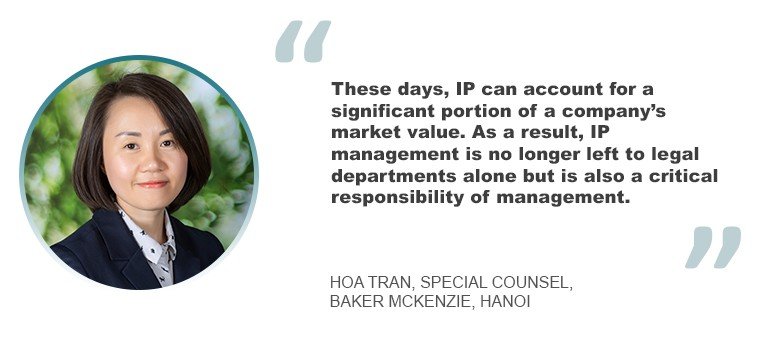What’s your IP strategy?
31 January 2024

Intellectual property strategies play a crucial role for businesses of all sizes. Espie Angelica A. de Leon discusses its importance and the needed priorities, including the likely steps during the process of an IP strategy’s development.
Does your company have an intellectual property strategy?
An IP strategy is a detailed plan for how a company intends to acquire, protect, use, maintain and enforce IP and IP-associated rights. It sets the goals of the company and enumerates a series of actions and means to make use of legal protection mechanisms available for their IP assets. The IP strategy should be designed to serve these business goals.
By developing an IP strategy, a business enterprise will be better able to protect, secure, commercialize, develop and enforce IP rights and other intangible assets. The company will also have a competitive advantage, make full use of IP intelligence information, promote the development of IP technology, control the market of IP technology, seek the best economic interests and seek long-term survival and continuous development.

“Having a good IP strategy is a must to minimize costs, save time and maximize protection while allowing the best possible return on investment,” said Franck Fougere, managing partner at Ananda IP in Bangkok. “It shall never be designed without taking into account competitors and, of course, the company’s business strategy.”
The strategists
Who should create the company’s IP strategy?
“Initially, the development of a business organization’s IP strategy would be in the hands of the founders of the said business as they were the ones who saw the vision for the enterprise as well as the initial route for its development,” said Sophia Editha Cruz-Abrenica, senior counsel at Villaraza & Angangco Law Office in Manila.
Business startups often have no full-time staff to handle IP protection. Hence, the work is usually done by project managers or administrative staff part-time. In some cases, external IP service agencies may be tapped to do the job or provide assistance. “This approach of part-time or outsourced IP protection can only be adopted at an early stage,” said Bin Zhang, attorney-at-law at CCPIT Patent & Trademark Law Office in Beijing. “When the enterprise has developed to a certain scale and the requirements for IP business have significantly increased, it should consider arranging full-time personnel to carry out corresponding work.”
Indeed, over time a business enterprise grows, giving birth to more departments within the organization such as the legal department. Hoa Tran, special counsel at Baker McKenzie in Hanoi, underscores that IP matters were traditionally confined to the legal domain due to their legal processes, such as filing, prosecuting, maintaining and enforcing. But, she says, the modern landscape demands a more integrated approach.

“These days, IP can account for a significant portion of a company’s market value. IP management thus necessitates the integration of legal processes with business strategies and objectives. As a result, IP management is no longer left to legal departments alone but is also a critical responsibility of management,” explained Tran. CEOs, for example, may set the overall strategic direction while CFOs evaluate the financial implications of an IP strategy.
For Fougere, it is important to consult everyone involved first. “It is advisable for technical staff such as engineers, sales, marketing, management, commercial and legal teams to be consulted prior to finalizing an IP strategy. Everyone in the company shall understand the goals, the actions and resources that will be spent to achieve the goals. Failure to bring everyone up to speed usually results in poor strategy or poorly implemented strategy,” he said, noting that day-to-day implementation of the IP strategy may be carried out by the IP department and/or an outside IP counsel.
According to Abrenica, it would be good to include feedback from frontline personnel, such as customer-facing and operations teams. The feedback they provide reveal other innovations which may be useful for developing the enterprise. This, in turn, could lead to new IP.
How to develop an IP strategy
Those responsible for developing a company’s IP protection strategy must have a comprehensive understanding of the business’s direction, objectives and external environment. Apart from the current and potential IP assets, several other factors must be considered: enterprise size and type, vision and goals, business sector, the IP landscape in the enterprise’s specific industry and geographic region, and allocated financial and human resources.
There is no single route for creating an IP strategy because every business is unique. However, people assigned to undertake the task commonly do the following:
- Have strong non-disclosure agreements (NDA) as part of the strategy.
“This is especially so at the very start when the business is still being founded, and key partners are recruited for the various needs of the enterprise, such as those who will be providing capital, business know-how, technical acumen, sales and marketing ability, human resource strategies and whatever is necessary for the budding enterprise,” said Abrenica.
Analyze the external environment of the enterprise, including the legal environment and overall situation of the creation of external IP rights, economic environment and intelligence of competitors.

- Conduct an internal audit.
Understand the IP protection situation of the enterprise itself, sort out and identify IP assets that will give the enterprise its competitive advantage. “Once their IP has been developed – or actually even during the development process – it may be wise to consult an IP advisor as to which IP may be ripe for protection as well as the recommended timeline for IP protection,” said Abrenica.
Sort out the firm’s existing IP management system, straighten out the organizational structure of management, clarify the distribution of powers and responsibilities of various management bodies, prepare the internal IP management system, analyze the IP creation ability of the enterprise, establish guidelines and procedures for IP creation and documentation and comprehensively review its brand building and promotion capabilities.
- Determine the vision and strategic goals of the enterprise’s IP rights. “Give short-, medium- and long-term development goals based on the type, quantity and quality of these IP rights,” said Zhang.
- Evaluate the IP portfolio for licensing. Abrenica explained: “For example, a franchise may involve not just trademarks but also copyrighted works, such as service manuals, advertising material, training books, audio and video tapes and the like, which can assist the licensee in promoting and developing the business. The franchise may also involve trade secrets, patents and utility models for improved products and services that are relevant to the enterprise. These can all be placed as subjects of a licensing agreement, with the ultimate purpose of developing the business.”
- Carry out full coordination and communication measures for the IP strategic plan, listen to the opinions of all relevant parties, optimize the plan design on this basis, and then create the IP strategy binding on the whole enterprise. “Set clear goals and objectives for the IP strategy,” said Tran.
- Allocate enterprise resources.
- Manage and control the implementation process of the IP strategy through the enterprise IP management system and the use of relevant standards.
“An IP strategy is strong and effective when it can enable and align with the business strategy,” Tran emphasized.
But, company officials should always bear in mind that IP strategies are never static. Hence, enterprises must periodically review their IP strategy to make sure it is attuned to changing conditions. To be more specific, it should be able to evolve with the business and respond to its growing needs, market expectations and the opportunities presented. At the same time, it should also be robust enough to address new threats and concerns that come with the changing times.
“The review of the enterprise’s IP strategy usually compares the implementation of the strategy with the expected goal, adjusts the implementation of the strategy and takes remedial measures according to the feedback information,” said Zhang.
Tran recommends an annual review, or whenever any substantial change in the business strategy or environment necessitates it, while Fougere suggested a biannual review, or “whenever necessary due to change of business objectives, budget available, new intangible assets to be protected and most importantly, competitor behaviour.”
Meanwhile, Abrenica recommended a quarterly review, noting the fast-paced world. “They should also check that their enterprise as a whole is sustainable and socially responsible in the use of their resources, including their IP,” she said.
IP strategy for startups
Startups are often short on funds and resources, so they delay creating an IP strategy and instead focus on other matters, such as product development. While this is also important, the crucial role of an IP strategy must not be overlooked.

“The purpose of the establishment of an enterprise’s IP strategy is mainly how to use IP to increase revenue and protect the existing income stream from the encroachment of competitors, and how to use IP to increase competitiveness and restrict competitors to expand its market share. This goal is in line with the goals of startups,” said Zhang.
According to Tran, IP is likely a startup’s most valuable intangible asset. “A sound IP strategy from the beginning can significantly enhance a company’s commercial value and help attract investors, suppliers, partners and more,” she said.
“If startups ignore the protection of IP rights and wait until the company grows up to establish relevant awareness,” revealed Zhang, “it will often lead to irreparable loss of their legitimate rights and interests.”
Our interviewees recommend that business startups do the following to protect their IP assets and be able to create an IP strategy:
- Register your company name, brand name and logo as soon as possible. Apply for patent protection in advance. Protect trade secrets by signing agreements with employees.
“Budget limitations may prevent startups from protecting all their IP at once. For this reason, it is critical to determine which IP should be prioritized at each stage of the company’s development and based on relevance to its value propositions,” noted Tran.
Echoing this sentiment, Abrenica emphasized that an IP strategy needs to flexibly align with the enterprise’s growth phases. “It should be simple enough at the start to be able to help the business grow, and slowly develop as the business expands,” she said.
Abrenica cited a business founded on the concept of efficient service delivery as an example. To stay true to its promise of efficient service, the enterprise may need to develop several methodologies and means that will allow it to do so. These various methodologies and means may include inventive processes and software, among others, which will be covered by patents and copyright respectively.
At the same time, it will have to develop a trademark for brand recognition. “It would then be advisable to have these protected, as these would serve as the initial competitive advantage of the enterprise. As the business grows and flourishes, further innovations will also be developed, and the business will need to set it further apart from the competitors who by now would have set up competing technologies of their own. Hence, new products, additional and/or better service methods may evolve, and new brands or sub-brands, tag-lines, commercialization methods, product packaging and designs may blossom as the business expands,” she explained.
- Consult an IP advisor as soon as the business is set up.
An IP advisor will help the business owner avoid early pitfalls, such as using and developing a mark that is not registrable at all or has already been registered in the first place.
An IP advisor will also help ensure that the IP strategy aligns with the firm’s marketing and sales strategies and its strategies for growing and developing the business.
- Do a good job of patent layout and have a long-term plan for future product projects.
- Have a global strategy in mind.
Tran said this can be a “huge advantage,” especially in the startup’s early stages. “Many startups wishing to expand into international markets discover their IP is unprotected in important markets. Therefore, it is advisable to consult IP experts about global and regional protection,” she shared.
According to Fougere, building an IP strategy doesn’t have to be costly. Start by taking initial steps, then raise funds for complete protection. ““You do not need to spend much to develop an IP strategy,” noted Fougere. “Once you have one, learn how to initiate first steps and then to raise funds for a complete protection. Investors will always favour startups who are able to answer questions regarding their IP,” he said.
It isn’t just investors. Overall, the gods of good business will favor enterprises – whether small, established or newly-formed – that pay enough attention to their intellectual property to actually find a reason to develop an IP strategy.
Does your business already have one?






